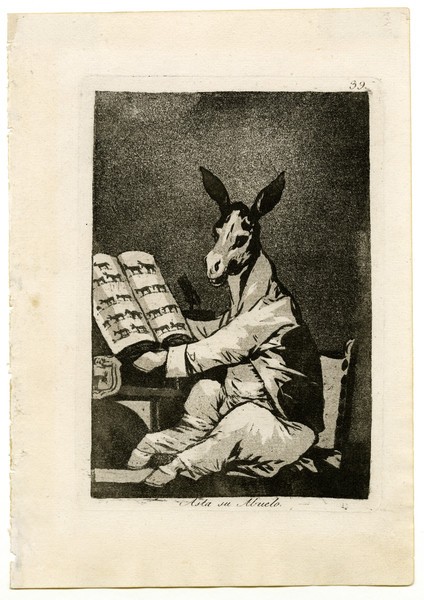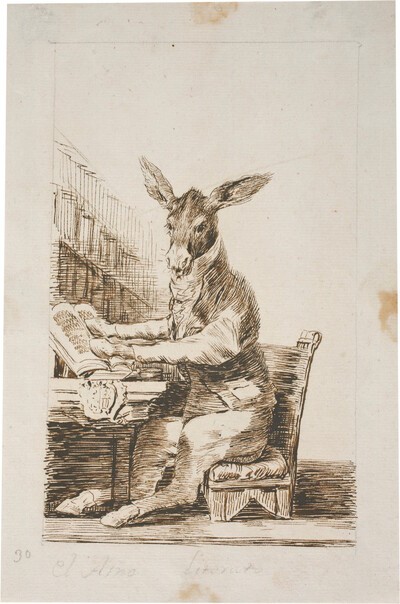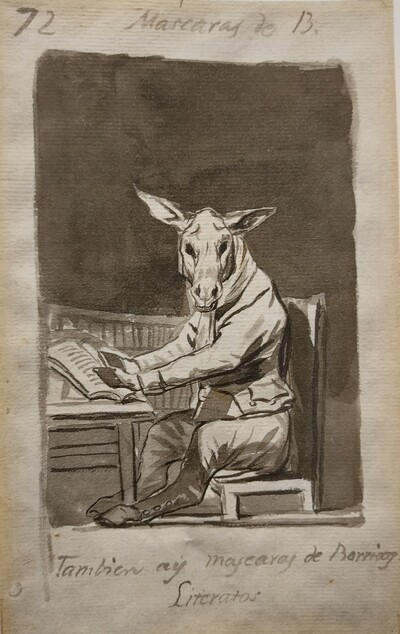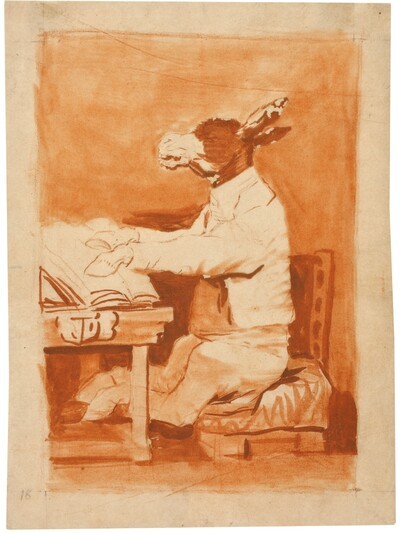- Cronología
- Ca. 1797 - 1799
- Dimensiones
- 214 x 150 mm
- Técnica y soporte
- Aguatinta
- Reconocimiento de la autoría de Goya
- Undisputed work
- Ficha: realización/revisión
- 13 Dec 2010 / 29 May 2024
- Inventario
- 225
Asta su Abuelo. (at the bottom)
39. (in the upper right-hand corner)
See Francisco de Goya y Lucientes, Painter.
Only a pre-print proof is known with the handwritten title, Hasta el treinta abuelo In the end, a shorter and more incisive title, was chosen for the final print.
Three preparatory drawings of this engraving have survived (1), (2) and (3).
In the centre of the composition is a donkey in costume, looking at the viewer. On a lectern in front of him is a book with rows of donkeys, as if it were his family tree. Beneath the book is a coat of arms with a donkey in the field. In the background, between the book and the donkey, the silhouette of an owl can be seen.
In this engraving Goya used only aquatint without resorting to etching. This demonstrates his considerable skill in the use of this technique, with which he creates the outline of the animal, the background and the details that can be seen in the print.
The manuscripts on The Caprices agree that it is a donkey trying to demonstrate its noble origins. In this way Goya was criticising the widespread practice among the aristocracy during the 18th century of seeking the origins of their noble titles. This activity was, in many cases, the most important occupation they had, as they often had no work at all.
One of the sources of inspiration for this print could be the work by Primo F. Martínez de Ballesteros (Logroño, 1745-Saint Esprit, 1830)Memoirs of the Insigne Asnal Academy in which he openly mocked the Spanish Royal Academy and the people who were strongly attached to the past who were at the forefront of the country's culture at the time. It is also possible that Goya was also familiar with The learned donkey. Original fable, a posthumous work by an anonymous poet published in 1782 by Juan Pablo Forner (Mérida, 1756-Madrid, 1797) and one of José Cadalso's Cartas Marruecas (1789). In it the following was said: "Hereditary nobility is vanity, which I base on the fact that eight hundred years before my birth one died who was called as I am called, and was a man of profit, although I am useless for everything".
Ayala's manuscript notes in brackets that this image could be a clear reference to Manuel Godoy (Badajoz, 1767-Paris, 1851), possibly because the Extremaduran had his family tree drawn up in search of noble ancestors. In the end he obtained a debatable descent from Gothic kings and, through his marriage to María Teresa de Borbón, ended up being related to the royal family itself.
Both the donkey and the owl, present in this engraving, appear frequently in many of Goya's works and form part of his personal iconography. The donkey in the so-called "asnerías", i.e. the prints of donkeys from 38 to 42 in the series of The Caprices, refer to ignorance. The owl that alludes to foolishness could have been taken from the emblem Fatuitas by Andrea Alciato (Alzano, Milan, 1492 - Pavia, 1550) in which this concept is symbolised precisely by this animal.
The plate is preserved in the National Chalcography (no. 210).
-
Goya. Gemälde Zeichnungen. Graphik. TapisserienKunsthalle BaselBasle1953from January 23th to April 12th 1953cat. 228
-
El arte de GoyaMuseo de Arte Occidental de TokioTokyo1971from 16th 1971 to January 23th 1972. Exhibited also at the Kyoto Municipal Museum of Art, January 29th to March 15th 1972.cat. 72
-
Goya y el espíritu de la IlustraciónMuseo Nacional del PradoMadrid1988from October 6th to December 18th 1988. Exhibited also at Museum of Fine Arts, Boston, January 18th to March 26th 1989; The Metropolitan Museum of Art, Nueva York, May 9th to July 16th 1989, Madrid curator Manuela B. Mena Marqués, scientific directors Alfonso E. Pérez Sánchez and Eleanor A. Sayrecat. 46
-
Goya. La década de Los CaprichosMadrid1992organized by Real Academia de Bellas Artes de San Fernando sponsored by Fundación Central Hispano, Madrid, consultant editor Nigel Glendinnig. From October 26th 1992 to January 10th 1993cat. 127
-
Francisco de GoyaMuseo d'Arte ModernaLugano1996exhibition celebrated from September 22nd to November 17th.cat. 39, p.66
-
Ydioma universal: Goya en la Biblioteca NacionalBiblioteca NacionalMadrid1996from September 19th to December 15th 1996cat. 136
-
Francisco Goya. Sein leben im spiegel der graphik. Fuendetodos 1746-1828 Bordeaux. 1746-1996Galerie KornfeldBern1996from November 21st 1996 to January 1997cat. 45
-
Goya artista de su tiempo y Goya artista únicoThe National Museum of Western ArtTokyo1999from December 1st to July 3th 1999cat. 118
-
Goya e la tradizione italianaFondazione Magnani RoccaMamiano di Traversetolo (Parma)2006consultant editors Fred Licht and Simona Tosini Pizzetti. From September 9th to December 3th 2006cat. 39, p.155
-
Goya. Opera graficaPinacoteca del Castello di San GiorgioLegnano2006exhibition celebrated from December 16th 2006 to April 1st 2007p.33
-
Goya luces y sombrasCaixaForumBarcelona2012consultant editors José Manuel Matilla and Manuela B. Marqués. From March 16th to June 24th 2012cat. 31
-
Goya et la modernitéPinacothèque de ParisParís2013from October 11st 2013 to March 16th 2014cat. 144
-
Hamburg2019cat. 80
-
Goya engravings and lithographs, vol. I y II.OxfordBruno Cassirer1964p.111, cat. 74
-
Vie et ouvre de Francisco de GoyaParísOffice du livre1970p.180, cat. 526
-
Goya, la década de los caprichos: dibujos y aguafuertesMadridReal Academia de Bellas Artes de San Fernando1992pp.211-216, cat. 124-128
-
La hidalguía de Goya. Nuevos documentos y una hipótesis sobre Capricho 39Boletín del Museo e Instituto Camón AznarZaragozaIbercaja1995pp.37-60
-
Catálogo de las estampas de Goya en la Biblioteca NacionalMadridMinisterio de Educación y Cultura, Biblioteca Nacional1996p.94, cat. 128
-
El libro de los caprichos: dos siglos de interpretaciones (1799-1999). Catálogo de los dibujos, pruebas de estado, láminas de cobre y estampas de la primera ediciónMadridMuseo Nacional del Prado1999pp.220-225
-
Francisco Goya. Los CaprichosBarcelonaEdiciones de la Central2011pp.16-17
-
MadridFundación bancaria “la Caixa” y Museo Nacional del Prado2012pp. 154-155
-
ParísPinacoteca de París2013p. 206
-
Goya. In the Norton Simon MuseumPasadenaNorton Simon Museum2016pp. 42-75
-
HamburgHirmer2019p. 293



